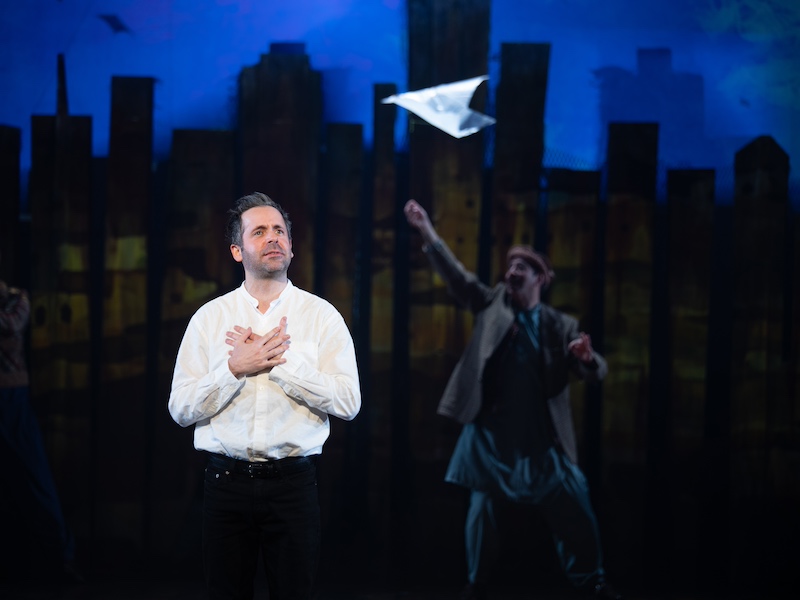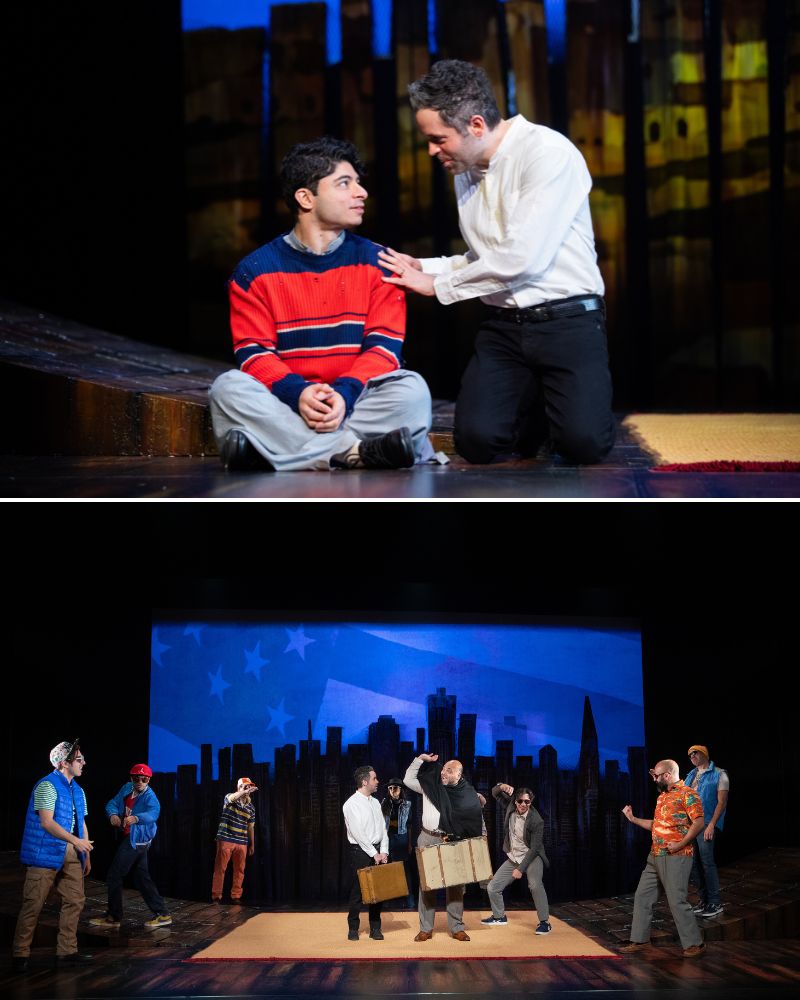It’s 1973 and two young boys, Amir and Hassan, race after a fallen kite through the streets of Kabul, Afghanistan. Friends from different castes — Amir is Pashtun and Sunni, Hassan is Hazara and Shia — they are too young to understand what those differences mean in the wider world. They are too young to realize that the world is about to crumble around them and too old to escape the impact of a country tearing (them) apart. Matthew Spangler’s adaption of Khaled Hosseini’s book by the same name, The Kite Runner weaves a fraught tale of fight, sacrifice, and flight across two decades and two continents as Amir struggles to grow into adulthood while carrying the scars of his childhood, his family, and of his people. A touring production directed by Giles Croft soaring high at the Kennedy Center for one week only, The Kite Runner is wound as tightly and as sharply as the glass-coated string of a fighting kite.

The story’s narrator, Amir, played by Ramzi Khalaf, is skillfully unreliable and unsteady as he traces his memories from 1973 to 2001. Running from the shame of his past — from that day his silence betrayed Hassan in the alley and the years that followed — Khalaf swung between memory and narration from breath to breath, meticulously adjusting his manner of speaking from anguished recounting using the sharp sounds of an American accent to the soft, round Farsi-accented speech of his younger self, deep in the moment of a memory. Never leaving the stage, his performance was powerful and exhausting as is only right for a story so deeply layered with agony and fight. His lingering pull to be better, do better, was unrelenting, and the choice of the production to never back away from Amir’s flaws and struggles to stand for something (or someone) was commendably executed.
Nearly always at his side, and a foil in every way, was Hassan, played by Shahzeb Zahid Hussain. Lacing devotion and loyalty into his every quiet move, Hussain was the heartbeat of the show. His playful glee in acting out westerns, his wise patience in waiting for the kite to fall, his steadfast commitment to those he loved were faithfully and endearingly delivered. Similar was the dignified loyalty and pride that his father, Ali, played by Hassan Nazari-Robati, showed in the care of Amir’s father’s estate where these two families lived side-by-side for decades.
In loud contrast was Amir’s father, Baba, played by the confident and skilled Haythem Noor. A successful businessman in Kabul before he and Amir fled to America, Baba deeply rooted himself in what he thought was right but also erratically struggled to balance (what he perceived to be a trade-off between) strength and the heart. Noor stood firm in the face of his perceived injustice but firmer still in his conflicted relationship with his son. For me, his range and comedic timing/exasperation channeled a self-assured, opinionated uncle.
Embodying a skin-crawlingly abhorrent character was Wiley Naman Strasser playing Assef, a sociopathic schoolyard bully. Naman Strasser’s ability to coat violent cruelty with an oily pose was stomach-turning in a way that such an antagonist required. It was in Assef’s yearslong taunting of Amir and Hassan that the shameful cowardice of Amir was made clear.
Amir’s aversion to conflict or fighting followed him even to America where in San Francisco he met the rebellious and opinionated Soraya, played by Awesta Zarif, and her traditional father, General Taheri, played by James Rana. Fellow members of the Afghan diaspora, they represented to me the tension within the community and with self — one looking to the future and one clinging to the past.
Flowing in and out of the story were also the wonderfully talented supporting and ensemble cast: Jonathan Shaboo (Rahim Khan/Dr. Schenider/Omar Faisal), Kevin Stevens (Ensemble/Merchant/Russian Soldier), Jade Ziane (Kamal/Zaman), and Sophie Zmorrod (Ensemble/Pomegranate Lady/Andrews). Forming an organic dance of moments and layers — by movement director Kitty Winter and fight director Philip D’Orleans — together they expanded this world to the edge of the stage and beyond.
Equally integral to the story was the care-filled attention to the sights, sounds, rhythms, melodies, and dances of Afghan culture woven lovingly throughout the production, led by Cultural Advisor and Dialect Coach Humaira Ghilzai and Tabla Artist Salar Nader. From the nikah ceremony joining Amir and Soraya to the attan — and even the intricately choreographed dance of the kites, as one by one they fell from the sky — this production is thoughtfully celebratory of the traditions of a culture torn apart so much and yet now held together in resilient community across the world.

Each design by the deeply synchronized creative team was reverently crafted. But in particular, I enjoyed the collaboration of lighting design by Charles Balfour and projection design by William Simpson guiding us through time, place, and memory with elaborate projections seemingly painted on a moving canvas and shrouded in the light of dusk or day; the scenic and costume design by Barney George with its jagged fence (is it a wall? a skyline?) and curved ramps leading to a woven central carpet that Amir used to step in and out of memory; and especially the production’s soundscape — the sound design of Drew Baumohl, Composer and Music Supervisor Jonathan Girling, and additional arrangements by Salar Nader — layered with singing bowls, tablas, schwirrbogen (a zither-like string instrument), and more, all played by the onlooking ensemble as musical witness to the tale unfolding.
A challenging journey of one man’s failure, flight, and fight, the national tour of The Kite Runner at the Kennedy Center is a tour de force of confrontation and the hope for redemption. One that forces you to look at your own life to see what you too might be running from, holding on to, and willing to fight for in order to try to be good again.
Running Time: Approximately two hours and 30 minutes, including one intermission.
The Kite Runner national tour plays through June 30, 2024, in the Eisenhower Theater at the Kennedy Center, 2700 F St NW, Washington, DC. Purchase tickets ($39–$149, with student rush and discounts available) at the box office, online, or by calling (202) 467-4600 or toll-free at (800) 444-1324.
The program for The Kite Runner is online here.
Recommended for age 13 and up. This production includes some content of a sensitive and mature nature and incorporates the sounds of gunshots.
COVID Safety: Masks are optional in all Kennedy Center spaces for visitors and staff. If you prefer to wear a mask, you are welcome to do so. See Kennedy Center’s complete COVID Safety Plan here.



